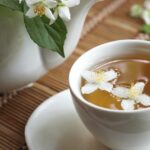Contents
A Brief History of Ginger Ale

The origins of ginger ale can be traced back to ginger beer, which was first brewed commercially in England during the mid-1700s. Back then, ginger beer was touted as a health drink made from ginger, sugar, water, lemon juice and a plant-derived fermenting agent. The brewing process gave it an alcoholic bite similar to beer.
It was in Ireland in the 1850s that ginger ale as we know it began taking shape. Irish pharmacist and chemist Thomas Joseph Cantrell is credited with developing carbonated ginger ale. Unlike ginger beer’s alcoholic fermentation, Cantrell’s ginger ale derived its bubbly carbonation from soda water. The result was a non-alcoholic ginger drink with a clean, refreshing taste.
Ginger ale’s popularity quickly spread beyond Ireland. But it was in Canada that ginger ale reached new heights of commercial success. Canadian pharmacist and businessman John McLaughlin launched Canada Dry Pale Ginger Ale in 1904 after perfecting his own ginger ale recipe.
Canada Dry built an empire around its ginger ale, establishing it as one of the world’s leading soft drink brands by the mid-1900s. The company’s memorable slogan “The Champagne of Ginger Ales” highlighted its dry, crisp taste. Canada Dry even invented the first diet ginger ale in 1958 to appeal to calorie-conscious drinkers.
Understanding Ginger Ale
While the term ginger ale nowadays refers to a wide range of carbonated ginger drinks, some key differences exist between traditional and modern ginger ales:
- Traditional ginger ale is brewed by fermenting ginger with yeast and sugar. This results in a beverage with a stronger ginger bite. The carbonation comes from the natural byproducts of fermentation.
- Modern commercial ginger ale is more heavily carbonated by adding pressurized carbon dioxide. The ginger flavor is mellower with more pronounced sweetness. These ginger ales have a longer shelf life compared to traditionally brewed versions.
Ginger ale should not be confused with ginger beer, despite some similarities. While both drinks contain ginger, ginger beer is brewed in a way that creates an alcoholic content between 0.5% to 2%. Ginger ale’s production methods ensure it remains completely non-alcoholic. In terms of taste, ginger beer has a much stronger ginger potency while ginger ale is lighter and sweeter.
Nutritional and Caffeine Content
One of the appeals of ginger ale for many is its lack of caffeine, making it a soda option safe for people who avoid stimulants or caffeine late in the day. Most mainstream ginger ale brands contain zero caffeine.
However, the drink’s sugar content is where nutritional considerations come into play. The amount of sugar per serving ranges quite a bit between brands, styles (regular versus diet), and serving sizes.
See more : Worried About Caffeine? What to Know About Jasmine Tea
To put it into perspective, here are the basic nutritional facts for a 180ml serving of Canada Dry regular ginger ale:
- Calories: 100
- Total fat: 0g
- Sodium: 25mg
- Total Carbs: 26g (25g sugar)
- Protein: 0g
So in a typical can, there are 140 calories and 33g of sugar. The American Heart Association recommends no more than 36g of added sugar per day for men and 25g for women. Just one serving of ginger ale provides nearly all of that amount.
Health Implications
While ginger ale makes for a tasty drink, it’s worth understanding its potential health implications when consumed regularly.
On the upside, ginger has well-documented medicinal properties. Ginger ale has long been used as a home remedy to ease indigestion and nausea due to ginger’s anti-inflammatory effects on the stomach. The carbonation can also help settle an upset stomach.
However, consuming full-sugar ginger ale on a frequent basis carries risks. The high sugar content (usually in the form of high fructose corn syrup) can contribute to obesity, diabetes and heart disease when consumed excessively. There are diet ginger ale options that use non-nutritive sweeteners, but there are concerns about links between artificial sweeteners and negative health outcomes.
As with many foods, moderation is key. Ginger ale remains a tasty beverage choice, but limiting intake to occasional treats makes the most nutritional sense. For those who drink ginger ale for stomach relief, brewing ginger tea a few times a week can provide therapeutic ginger without excess sugars.
Cultural and Culinary Uses
Beyond just being a soda drink, ginger ale holds unique roles in culinary traditions and cultural practices across the globe.
In many Caribbean and West African cuisines, ginger ale or ginger beer is mixed with various fruit juices or used to marinate meats for its subtle sweet-spicy flavor.
The drink is also integral to shandies. This beer cocktail originated in England, combining ginger ale or ginger beer with lager or pale ale. The refreshing, bubbly shandy rose to popularity with British sailors traveling to tropical regions.
See more : How Much Caffeine is in a Starbucks Refresher?
Ginger ale remains an integral mixer for many classic and modern cocktails. A Moscow Mule contains vodka, lime juice and ginger ale. Whiskey highballs, juices and ginger ale also make perfect pairings.
In various folk medicines, ginger ale was believed to aid digestion and circulation. Drinking homemade ginger ale was a common remedy given to women after childbirth. However, many of these claimed health benefits are unproven.
Today, Canada Dry brand ginger ale is intrinsically linked with holiday recipes and gatherings in the United States. Its sweet-spicy profile perfectly complements baked ham or mixes into festive punches. Serving ginger ale remains a staple at family dinners and parties for many Americans.
Consumer Guidance
Given its sweet taste, ginger ale may seem like just another sugary soda. But being an educated consumer can help ensure you choose the healthiest options. Here are some tips:
- Check the nutrition labels and select brands made without high fructose corn syrup or artificial sweeteners when possible.
- Opt for ginger ales with short ingredients lists. They tend to have less added sugars and preservatives.
- Look for brands that use concentrated ginger extract versus just ginger flavoring. This provides more authentic ginger taste and potential benefits.
- Enjoy ginger ale in moderation. Limit to the occasional treat drink or mixer rather than daily consumption.
- Consider diluting full-calorie ginger ale with seltzer water or club soda to cut down on sugars.
- For home use, try making ginger simple syrup. Mixing it with seltzer or club soda makes a homemade ginger ale with total control over sweetness.
Environmental and Ethical Considerations
With environmental concerns top of mind for many, it helps to know a bit about ginger ale production. Mainstream commercial ginger ales are made by major beverage corporations like Canada Dry and Seagram’s.
These big soda companies have faced scrutiny around sustainability practices, like Coke’s bottled water extraction impacts. But many brands are setting eco-friendly goals, like cutting plastic packaging and emissions. Consumers can help by recycling bottles and cans after use.
When it comes to ethics, some ginger ale brands tout social causes, like supporting first responders. But lawsuits have alleged discrimination and unfair labor practices at major soda companies. Consumers can consider supporting smaller, mission-driven ginger ale producers who prioritize ethical standards.
Conclusion
With its crisp, sweet taste with a kick of ginger spice, it’s no wonder ginger ale has been a favorite soda for ages. Tracing its roots as a homemade tonic to a globally popular soft drink, ginger ale remains a staple beverage in many cultures. While best enjoyed moderately, understanding its history, uses and health considerations allows consumers to fully appreciate this beloved bubbly drink.
Chef Angelo Landi has been in the culinary industry for over 20 years, and he has spent the last six of those developing the menu for Coal Vines. His favorite pizza on the menu is the Spicey Meatball, which is made with spicy sausage, pepperoni, and calabrese salami. When he’s not in the kitchen cooking up a storm, Chef Angelo enjoys spending time with his wife and two young children.








